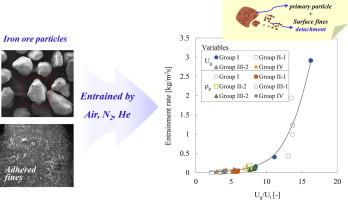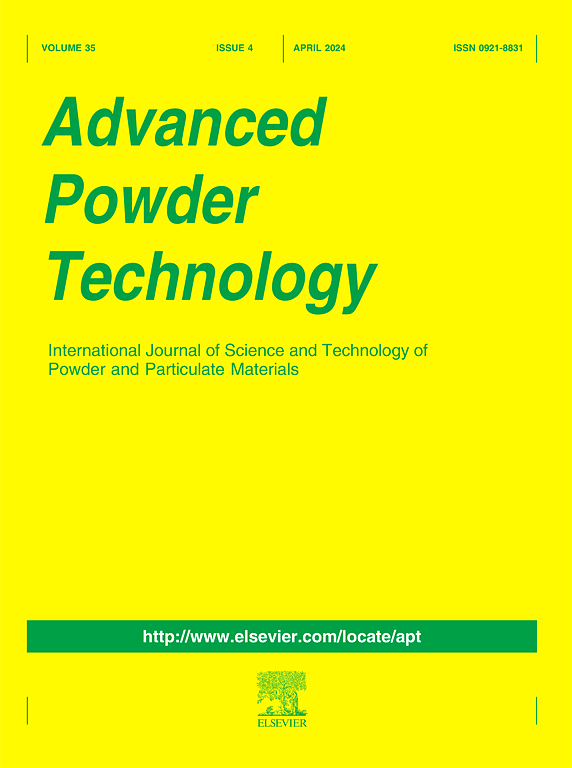Entrainment behavior of iron ore particles in a fluidized bed under varying gas properties
IF 4.2
2区 工程技术
Q2 ENGINEERING, CHEMICAL
引用次数: 0
Abstract
This study investigates the entrainment characteristics of iron ore particles under varying gas properties, considering the low-density gas conditions of reducing agents in a fluidized bed for hydrogen-based iron reduction. Experiments were conducted in a fluidized bed (0.05 m I.D × 3.05 m high) using iron ore particles (125–2800 μm) and gases of different densities. Iron ore particles were characterized by a high fraction of fines smaller than 45 μm (F45), which adhered to the surfaces of primary coarse particles. The laser diffraction method effectively evaluated the particle size distribution of iron ore. The total entrainment rate (Gs) increased with gas velocity (Ug) and gas density (ρg), with the increase being more pronounced at higher F45. The entrainment of coarse particles with terminal velocities (Ut) higher than a given Ug was affected by the entrained flow of fine particles. Gs consistently exhibited an exponential increase with increasing Ug/Ut across varying Ug and gas properties. The size ratio of critical to coarse particles (dcrit/dp,coarse) was identified as a physical factor to interpret the entrainment of adhered fines from coarse particles. A correlation was proposed to predict Gs by incorporating Ug/Ut, Archimedes number, and particle characteristics such as F45 and dcrit/dp,coarse.

不同气体性质下铁矿颗粒在流化床中的夹带行为
考虑氢基铁还原流化床还原剂的低密度气体条件,研究了不同气体性质下铁矿颗粒的夹带特性。采用粒度为125 ~ 2800 μm的铁矿颗粒和不同密度的气体,在直径0.05 m ×高3.05 m的流化床中进行了实验。铁矿颗粒的特点是含有大量小于45 μm (F45)的细小颗粒,这些细小颗粒粘附在原生粗颗粒表面。激光衍射法有效地评价了铁矿的粒度分布,总夹带速率(Gs)随气速(Ug)和气密度(ρg)的增大而增大,且在F45较高时增大更为明显。终端速度(Ut)大于给定Ug的粗颗粒的夹带受细颗粒夹带流的影响。在不同的Ug和气体性质下,Gs随Ug/Ut的增加呈指数增长。临界颗粒与粗颗粒的尺寸比(dcrit/dp,粗)被确定为解释粗颗粒粘附细颗粒夹带的物理因素。结合Ug/Ut、阿基米德数、F45、dcrit/dp、coarse等粒子特征,提出了预测Gs的相关性。
本文章由计算机程序翻译,如有差异,请以英文原文为准。
求助全文
约1分钟内获得全文
求助全文
来源期刊

Advanced Powder Technology
工程技术-工程:化工
CiteScore
9.50
自引率
7.70%
发文量
424
审稿时长
55 days
期刊介绍:
The aim of Advanced Powder Technology is to meet the demand for an international journal that integrates all aspects of science and technology research on powder and particulate materials. The journal fulfills this purpose by publishing original research papers, rapid communications, reviews, and translated articles by prominent researchers worldwide.
The editorial work of Advanced Powder Technology, which was founded as the International Journal of the Society of Powder Technology, Japan, is now shared by distinguished board members, who operate in a unique framework designed to respond to the increasing global demand for articles on not only powder and particles, but also on various materials produced from them.
Advanced Powder Technology covers various areas, but a discussion of powder and particles is required in articles. Topics include: Production of powder and particulate materials in gases and liquids(nanoparticles, fine ceramics, pharmaceuticals, novel functional materials, etc.); Aerosol and colloidal processing; Powder and particle characterization; Dynamics and phenomena; Calculation and simulation (CFD, DEM, Monte Carlo method, population balance, etc.); Measurement and control of powder processes; Particle modification; Comminution; Powder handling and operations (storage, transport, granulation, separation, fluidization, etc.)
 求助内容:
求助内容: 应助结果提醒方式:
应助结果提醒方式:


